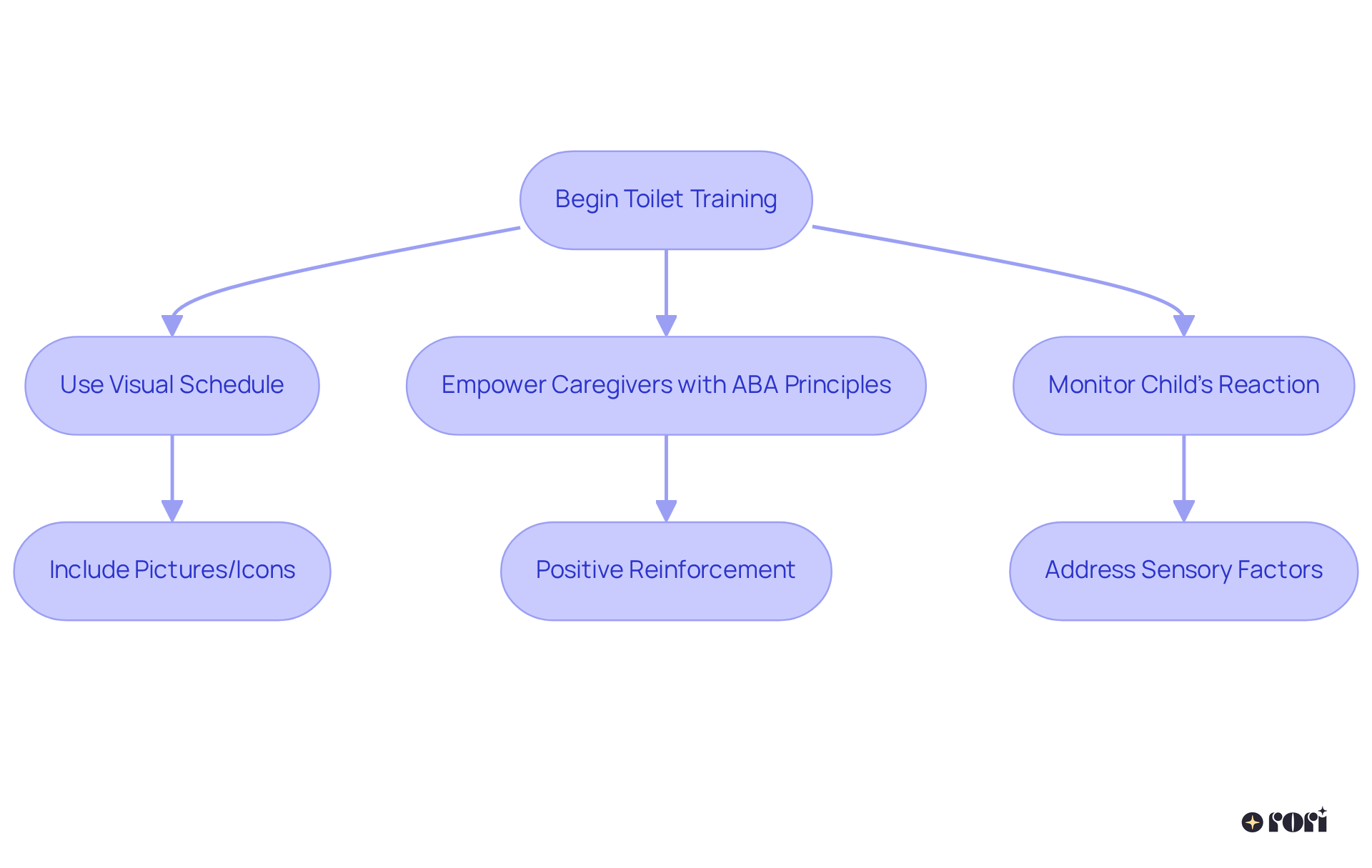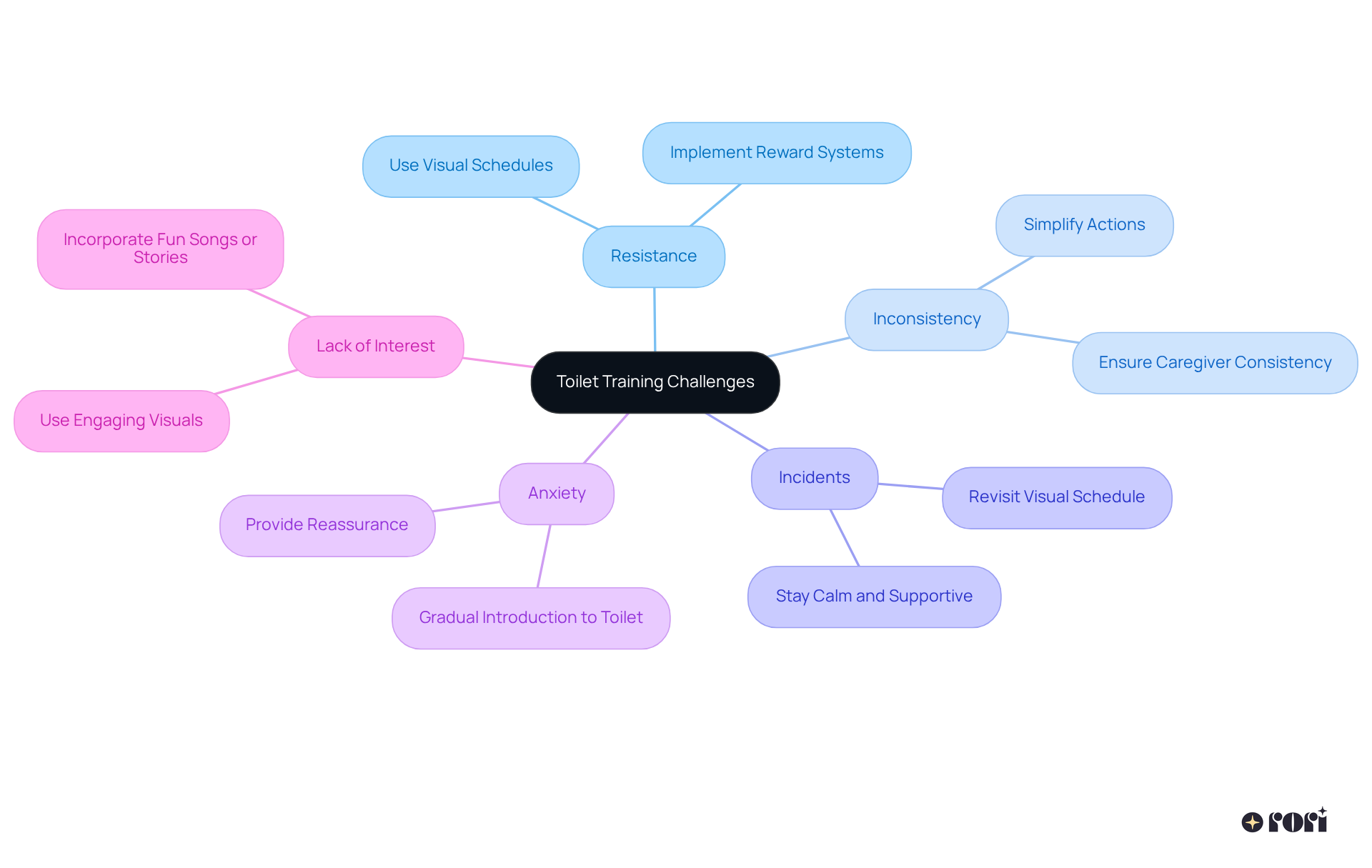This article offers a friendly step-by-step guide on creating an autism toilet training visual schedule. It highlights how this tool can significantly help children on the autism spectrum navigate the toilet training process with ease. By detailing actionable steps for caregivers, it emphasizes the importance of implementing visual aids, promoting consistency, and encouraging positive reinforcement. Ultimately, this approach fosters independence and helps reduce anxiety during training.
Let’s explore this together! With these strategies, you can support your child in a way that feels manageable and effective. Remember, you’re not alone in this journey—many parents share similar experiences and challenges. By using visual aids, you can create a comforting routine that makes the process smoother for everyone involved. We’re here to help you every step of the way!
Visual schedules have become essential tools in the world of toilet training for children with autism. They transform what can often feel like an overwhelming process into a structured and manageable experience. By breaking down each step into clear visuals, caregivers can help foster independence and reduce anxiety, making the journey to successful bathroom habits feel more achievable.
However, many parents encounter challenges that can hinder progress. It’s completely normal to feel a bit lost at times! How can caregivers effectively navigate these hurdles while ensuring their child feels supported and confident throughout the training process? Let’s explore this together!
Visual schedules, especially the autism toilet training visual schedule, are such valuable tools for helping our little ones with autism navigate the restroom preparation process! They provide an autism toilet training visual schedule that offers a clear and organized picture of what to do when using the restroom, transforming what can be a daunting task into a predictable experience. Kids on the autism spectrum often thrive on routine and organization, so using an autism toilet training visual schedule helps break down bathroom learning into manageable steps. This not only clarifies what’s expected but also promotes independence as young learners figure out how to follow the schedule on their own.
It's essential to empower caregivers with ABA principles and strategies in this journey. By utilizing an autism toilet training visual schedule that includes pictures or icons to illustrate each step, parents and caregivers can create a supportive environment that significantly boosts the chances of successful bathroom learning. Visual aids, including an autism toilet training visual schedule, have been shown to improve understanding and reduce anxiety, making the whole training experience more positive for both kids and their families.
Moreover, educating caregivers is key to making informed decisions and enhancing support. When caregivers learn about positive reinforcement methods—like praise, sticker charts, and small rewards—they can help build a positive association with bathroom use, further encouraging their little ones.
It's also crucial for caregivers to pay attention to how their children react to different textures and scents related to toileting materials. These factors can really impact their comfort and willingness to engage in the process. Understanding the communication challenges and behavioral hurdles that children with autism might face during the autism toilet training visual schedule is vital for developing effective strategies.
Additionally, delays in bathroom learning can affect social interactions and health outcomes for autistic youths. This underscores the importance of timely and effective interventions. By actively involving caregivers and equipping them with the right knowledge and tools, we can significantly improve their ability to support their child's goals. Sharing real-world examples of using an autism toilet training visual schedule can enhance engagement and relatability for parents, providing practical insights into fostering successful bathroom habits. Let’s explore this together!

Creating an autism toilet training visual schedule as a step-by-step guide can be a game-changer for parents! Let’s dive into some actionable steps that can make this process smoother for you and your little one.
Identify Key Actions: Start by breaking down the potty training journey into clear, distinct phases. Common steps include recognizing the need to go, heading to the bathroom, pulling down pants, sitting on the toilet, wiping (if applicable), flushing, and washing hands. Simple, right?
Use Visual Supports: For each step, choose images or symbols that represent the action. You can use pictures from magazines, drawings, or digital images. It’s important to keep the visuals straightforward and easy to understand, as many nonverbal kiddos benefit from an autism toilet training visual schedule more than from spoken instructions!
Organize the Schedule: Arrange these visuals in a logical sequence, whether on a poster board or in a digital format. Make sure the schedule is easily accessible in the bathroom, ideally placed near the toilet so it’s visible during those important training sessions.
Introduce the Schedule: Take a moment to explain the visual schedule to your child using simple language. Walk them through each step, pointing to the corresponding visual as you go. This gradual introduction helps little ones grasp the process and eases any anxiety they might have. It’s all about making them feel supported!
Practice Consistently: Encourage your child to refer to the visual schedule each time they need to go. Regular practice is key; toilet training won’t happen overnight. It takes time and plenty of repetition to solidify those steps and build confidence. And remember, accidents are totally normal—view them as learning opportunities!
Encourage and Praise: Celebrate your child’s progress with lots of encouragement and praise! Positive reinforcement is essential for helping them gain independence in using the restroom. Your support and knowledge can significantly enhance their learning experience and improve family dynamics.
Set Measurable Goals: Establish clear, measurable objectives for your child’s toilet training journey. This might include tracking successful attempts or the frequency of accidents. Keeping an eye on these goals helps you make informed decisions and adjust strategies as needed.
Adjust as Needed: Keep an eye on your child’s progress and be open to tweaking the visual schedule based on their needs and preferences. If certain actions are tricky, consider adding more visuals or simplifying the steps. Monitoring how many steps they can do independently can help identify patterns and refine your approach.
By following these strategies, you can create an autism toilet training visual schedule that encourages your child’s independence in bathroom habits. It’s all about fostering a positive learning experience! Research shows that ABA methods in toilet education boast over a 90% success rate, highlighting the effectiveness of these strategies and the importance of caregiver involvement in achieving those successful outcomes. Let’s explore this together!
![]()
Toilet training can be a bit tricky, but with the right strategies, you can navigate these challenges together! Let’s dive into some common issues and helpful tips:
Resistance to Using the Toilet: Did you know that nearly 50% of individuals with autism experience toileting resistance? If your little one is hesitant, take a moment to revisit the autism toilet training visual schedule for guidance. Make sure it’s clear and engaging! A fun reward system, like stickers or small treats, can really motivate them to join in the fun.
Inconsistency in adhering to the autism toilet training visual schedule: If your child struggles to follow this schedule consistently, consider simplifying the actions or adding more visuals. Consistency is key, so it’s important that all caregivers are on the same page to reinforce what they’re learning.
Incidents: Remember, incidents are a normal part of the bathroom training journey! When they happen, stay calm and supportive. Use the autism toilet training visual schedule to remind your child of the steps, encouraging them to try again next time. It’s all part of the learning process!
Anxiety or Fear: If your child shows signs of anxiety or fear about using the restroom, it’s okay to take a step back. Offer reassurance and consider introducing the toilet in a more gradual way. Perhaps let them sit on it fully clothed at first to help them feel more comfortable.
Lack of Interest: If your child seems uninterested in bathroom habits, let’s make it more fun! Use engaging visuals, catchy songs, or stories related to bathroom routines to capture their attention. This can help create a positive association with using the restroom.
By anticipating these challenges and having some strategies ready, you can create a supportive environment that makes toilet training a smoother experience. Remember, patience and consistency are your best friends on this journey! We’re here to help you every step of the way!

Visual schedules are such a helpful tool in the toilet training journey for children with autism! They can really transform what might feel like an overwhelming process into something structured and manageable. By using an autism toilet training visual schedule, caregivers can provide clarity and foster independence, helping children navigate bathroom routines with more confidence. This approach not only enhances understanding but also significantly reduces anxiety, making the transition to independent toileting smoother.
Let’s talk about how to create an effective visual schedule! It’s important to:
Plus, positive reinforcement and educating caregivers play a critical role in supporting children through common challenges like resistance, inconsistency, and anxiety. By paying attention to each child's unique needs and adjusting strategies as needed, caregivers can create a warm environment that encourages success.
Ultimately, the importance of using an autism toilet training visual schedule really can’t be overstated. This method not only helps achieve successful bathroom habits but also empowers families to tackle the challenges of toilet training with patience and understanding. By embracing these strategies and fostering a positive learning atmosphere, caregivers can truly help their children thrive in this essential life skill, paving the way for greater independence and improved social interactions. Let’s explore this journey together!
What are visual schedules and why are they important for toilet training?
Visual schedules are tools that provide a clear and organized picture of the steps involved in using the restroom. They are particularly valuable for children with autism, as they help transform the potentially daunting task of toilet training into a predictable experience.
How do visual schedules help children on the autism spectrum?
Children on the autism spectrum often thrive on routine and organization. Visual schedules break down bathroom learning into manageable steps, clarify expectations, and promote independence as children learn to follow the schedule on their own.
What role do caregivers play in the toilet training process?
Caregivers are essential in empowering children through the use of ABA principles and strategies. By utilizing visual schedules and positive reinforcement methods, caregivers can create a supportive environment that enhances the chances of successful bathroom learning.
What types of visual aids should be included in an autism toilet training visual schedule?
An autism toilet training visual schedule should include pictures or icons that illustrate each step of the toilet training process, helping to improve understanding and reduce anxiety.
How can positive reinforcement methods assist in toilet training?
Positive reinforcement methods, such as praise, sticker charts, and small rewards, help build a positive association with bathroom use, encouraging children to engage in the process.
Why is it important for caregivers to understand their child's reactions to toileting materials?
Paying attention to how children react to different textures and scents related to toileting materials can significantly impact their comfort and willingness to engage in the toilet training process.
What challenges might children with autism face during toilet training?
Children with autism may experience communication challenges and behavioral hurdles that can affect their ability to engage with the toilet training process. Understanding these challenges is vital for developing effective strategies.
What are the potential consequences of delays in bathroom learning for autistic youths?
Delays in bathroom learning can negatively impact social interactions and health outcomes for autistic youths, highlighting the importance of timely and effective interventions.
How can sharing real-world examples enhance the toilet training experience for parents?
Sharing real-world examples of using an autism toilet training visual schedule can enhance engagement and relatability for parents, providing practical insights into fostering successful bathroom habits.